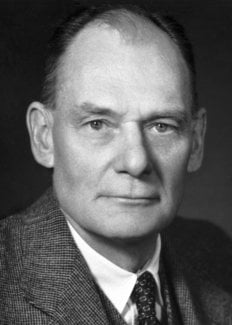John F. Enders
Biographical

John Franklin Enders was born on February 10th, 1897, at West Hartford, Connecticut, U.S.A. He is the son of John Ostrom Enders, a banker in Hartford, and Harriet Goulden Enders (née Whitmore).
Enders was educated at the Noah Webster School at Hartford and St. Paul’s School in Concord, New Hampshire. Finishing school in 1915, he went to Yale University, but in 1917 left his studies there to join the U.S. Naval Reserve (Air Force). Early in 1918 he qualified as a pilot and received the grade of Ensign. After the First World War he returned to Yale and was given, in 1919, the degree of B.A. (honoris causa) and the normal degree in 1920.
He then went into business in real estate in Hartford, but, becoming dissatisfied with this, he entered Harvard University. For four years he studied English literature and Germanic and Celtic languages with the idea of becoming a teacher of English, but he was not satisfied with this career either. He had been for a long time interested in biology and this interest was reawakened by his friendships with medical students at Harvard, with the result that he decided to enter as a candidate for the Ph.D. degree in bacteriology and immunology. In coming to this decision he was influenced by the late Professor Hans Zinsser, who was then Head of the Department of Bacteriology and Immunology at Harvard and by Dr. H. K. Ward, who later became Professor of Bacteriology at the University of Sidney, Australia.
In 1930, Enders received the degree of Ph.D. at Harvard for a thesis which presented evidence that bacterial anaphylaxis and hypersensitivity of the tuberculin type are distinct phenomena.
From 1930 until 1946, Enders remained at Harvard as a member of the teaching staff. During this period he studied, first, the elucidation of certain factors related to bacterial virulence and the resistance of the host organism. He then clarified, in collaboration with Ward, Shaffer, Wu, and others the inhibitory effect of the type specific capsular polysaccharides of Pneumococcus upon the phagocytic process. This work discovered a new form of Type I polysaccharide and produced evidence that complement played a catalytic-like part in the opsonization of bacteria by specific antibody.
In 1938, Enders began the study of some of the mammalian viruses, and undertook, in 1941, in collaboration with Cohen, Kane, Levens, Stokes and others, a study of the virus of mumps. This work provided serological tests for the diagnosis of this disease and a skin test for susceptibility to it, and demonstrated the immunizing effect of inactivated mumps virus and the possibility of attenuating the virulence of this virus by passing it through chick embryos. It was shown that mumps often occurs in a form that is not apparent, but nevertheless confers a resistance which is as effective as that conferred by the visible disease.
In 1946, Enders was asked to establish a laboratory for research in infectious diseases at the Children’s Medical Center at Boston. In this laboratory much outstanding work on the viral diseases of man has been done under his direction and it was here that the work was done on the cultivation of the poliomyelitis viruses for which Enders was awarded, together with T. H. Weller and F. C. Robbins, the Nobel Prize for Physiology or Medicine in 1954.
Since this time Enders has returned, in collaboration with Peebles, to his earlier work on measles. He is now Higgins University Professor at Harvard University and Chief of the Research Division of Infectious Diseases of the Children’s Hospital, Boston, Massachusetts, U.S.A.
Enders is a member of a great number of American learned societies, the Society for General Microbiology and the Royal Society for the Promotion of Health in Great Britain, the Deutsche Akademie der Naturforscher (Leopoldina), and is Foreign Corresponding Member of the British Medical Association and the Académie Royale de Médicine de Belgique.
He married Sarah Frances Bennett, of Brookline, Massachusetts, in 1927. She died in 1943, and in 1951 Enders married Carolyn B. Keane of Newton Center, Massachusetts. He has one son John Ostrom Enders II, one daughter, Sarah Enders, and a stepson, William Edmund Keane.
This autobiography/biography was written at the time of the award and first published in the book series Les Prix Nobel. It was later edited and republished in Nobel Lectures. To cite this document, always state the source as shown above.
John F. Enders died on September 8, 1985.
Nobel Prizes and laureates
Six prizes were awarded for achievements that have conferred the greatest benefit to humankind. The 12 laureates' work and discoveries range from proteins' structures and machine learning to fighting for a world free of nuclear weapons.
See them all presented here.
